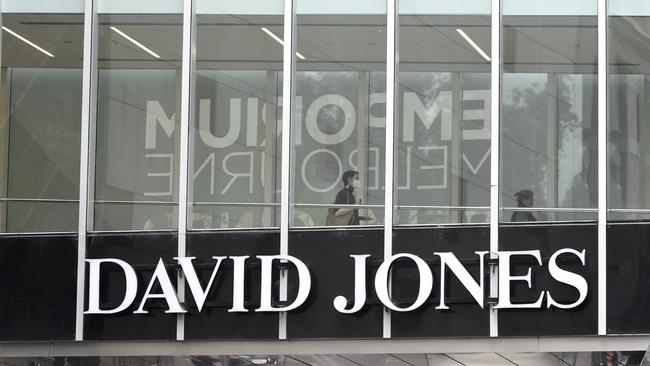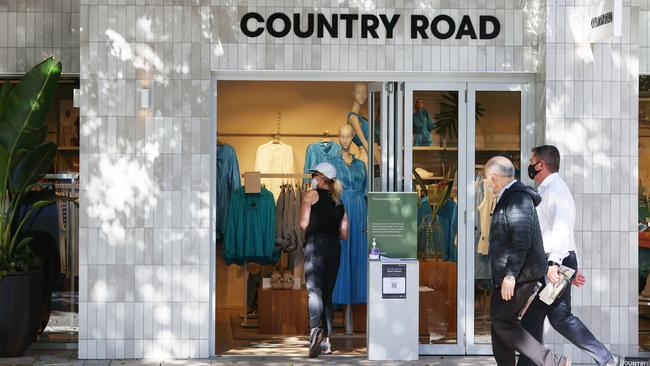David Jones and Country Road sales hit by weaker consumer confidence
David Jones and fashion stable Country Road Group have revealed a sharp slowdown in sales, blaming rising interest rates and a deterioration in trading conditions.
David Jones and fashion stable Country Road Group have revealed a sharp slowdown in sales, blaming rising interest rates and a deterioration in trading conditions that is keeping customers away from stores.
Cratering sales for the department store and the chains that sit within Country Road Group – Country Road, Mimco, Witchery, Politix and Trenery – paint a dire picture of the nation’s $400bn retail sector, which is facing an anxious consumer squeezed by cost of living pressures.
South Africa’s Woolworths Holdings issued a trading update for the year to the end of June, warning of slowing sales momentum at David Jones, which was sold earlier this year to a private equity firm for $100m, and the Country Road Group which it still owns.
It blamed wilting consumer confidence caused by Reserve Bank rate hikes for the worsening growth, with saw the formerly robust sales growth at DJs and Country Road Group nearly grind to a halt in the six months to June.
“Following a very strong first half result, trading momentum saw a pronounced deceleration in the second half, as the impact of sustained increases in interest rates and higher costs of living weighed on consumer confidence and discretionary retail spend,” Woolworths said in a trading update issued to the Johannesburg Stock Exchange.

Country Road Group sales grew by 12 per cent and by 12.4 per cent in comparable stores. However, as RBA governor Philip Lowe tightened the screws on home borrowers and ratcheted rates higher in the new year, sales growth in the second half slowed to just 0.6 per cent.
At the recently sold David Jones, turnover and concession sales for the current year fell 11.3 per cent relative to the statutory 12 months reported in the prior year. Turnover and concession sales on a comparable nine-month basis did rise by 21 per cent in comparable stores, partly helped by a post-Covid shopping bounce that is quickly disappearing.
David Jones chief executive Scott Fyfe said trading conditions had deteriorated over the past few months.
“Off the back of strong sales, we have certainly seen tougher trading conditions in the past two months, with the most recent interest rate increases and rising cost of living impacting consumer confidence,” he said.
Last month The Australian revealed leaked David Jones sales data that underlined the rising danger to the retail sector as consumers rein in spending, with stores experiencing double-digit sales collapses – some as much as 30 per cent.
Those leaked sales spreadsheets showed widespread falling sales across its flagship stores as well as suburban and regional centres between June 4 and June 10. It included sales for David Jones’ Warringah Mall store in Sydney (down 20.54 per cent year on year), and in Melbourne’s Highpoint shopping centre (down 20.16 per cent), while at Eastland David Jones, on the fringes of eastern Melbourne, sales were down 38.96 per cent compared with the same period last year.

Even in the affluent Melbourne suburb of Malvern the local David Jones store has booked a 19.01 per cent sales decline compared with the same time last year.
Just before Christmas last year Woolworths Holdings agreed to sell David Jones to private equity firm Anchorage for about $100m, a fraction of the $2.1bn it paid for the chain in 2014.
Now Anchorage will face the task of improving the performance of the 185-year-old retailer at a time when conditions are robbing consumers of discretionary spending power.
In June David Jones boss Mr Fyfe said the RBA rate rises in May and June had a significant impact on traffic at its stores, while the fashion and broader retail sector was pushing through high discounting to clear unwanted stock.
In March Myer released its half-year results with strong first-half sales growth of 24.2 per cent, but a trading update noted that sales growth had slowed to 16.1 per cent in the eight weeks after Christmas.
As reporting season is about to step up this week investors will be keeping a close eye on retailers to detect any further weakening in trading conditions, with a dozen ASX-listed retailers already issuing profit warnings in the lead-up to this results season.
Last week the Bureau of Statistics released retail sales for June that shocked many economists, with weaker than expected activity. Food was the only category to report a sales lift and department stores suffered an ominous 5 per cent monthly decline.
Retail sales fell 0.8 per cent in June.







To join the conversation, please log in. Don't have an account? Register
Join the conversation, you are commenting as Logout